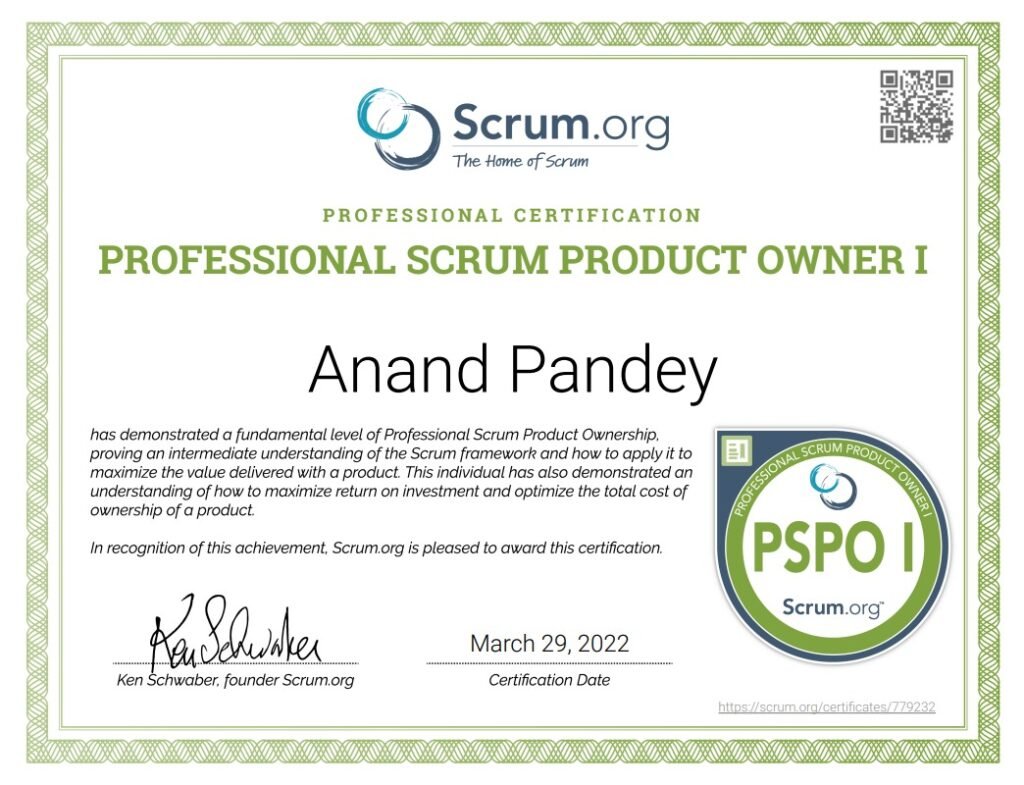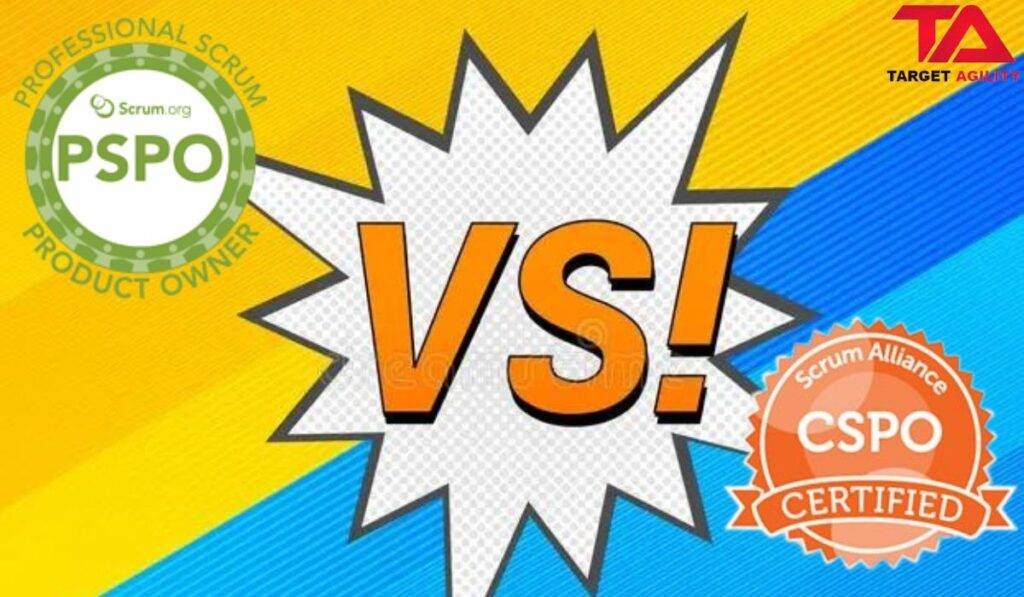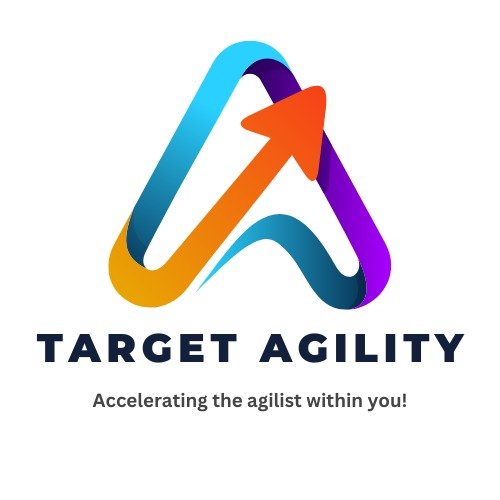How to Pass PSPO Exam In First Attempt?

Product Owners must have a deep grasp of their product’s value drivers and a clear understanding of how to effectively leverage agile processes like Scrum to optimize that value. The PSPO exams allow people to validate and certify their grasp of the Product Owner position and how they would behave in real-world circumstances. What is PSPO? Anyone who wants to show an advanced understanding of Professional Scrum Product Ownership, the Scrum framework, and delivering meaningful products should take the Professional Scrum Product Owner level II (PSPO II) assessment. The PSPO II Certification is awarded to those who pass the test and demonstrate that they have mastered the content. It takes numerous hours of hard work and most importantly PSPO 2 preparation to pass the Professional Scrum Product Owner II PSPO-II exam. Why having the Professional Scrum Product Owner Certification is Important The PSPO certification exam is beneficial as it helps organizations utilize the Scrum framework effectively in their IT department. Scrum is beneficial for maintaining product development, and having a certified background in product ownership within Scrum is beneficial. Scrum Product Owner certification can enhance job prospects, with an average annual salary of $110,000, making it beneficial for Product Managers or those aspiring to enter product management. A Scrum Product Owner certification may be extremely useful if you are a Product Manager or want to enter product management. What does a Scrum Product Owner Do? A Scrum Product Owner maximizes product value and manages the Product Backlog, utilizing various methods based on company, Scrum Team, and individual. Product Backlog Overview The Product Owner, a single individual, can perform or delegate duties, but remains in charge. They must have respect from the organization, influencing the Product Backlog and inspectable increments. They represent stakeholder demands, and those wishing to change should persuade them. If you are interested in exploring PSPO in-depth, we encourage you to sign up for course and upskill yourself. – PSPO I – PSPO II How to Prepare for Professional Scrum Product Owner (PSPO) 1. Start with the basics It is critical to have a solid foundation while studying for any exam. It is necessary to master the principles of important areas. So better take a training from professional scrum masters. 2. Learning Resources It is critical to be well-prepared and equipped with the necessary resources. To pass any exam, you must work carefully, effectively, and wisely. Target Agility have produced some learning materials to assist you in finding out more about Professional Scrum Product Owner (PSPO) 3. Get your hands-on training Target Agility Provides the PSPO class. We have had a lot of positive responses from the audience. Review From Audience: 𝘐 𝘢𝘵𝘵𝘦𝘯𝘥𝘦𝘥 𝘈𝘯𝘢𝘯𝘥 𝘚𝘪𝘳’𝘴 𝘵𝘳𝘢𝘪𝘯𝘪𝘯𝘨 𝘳𝘦𝘤𝘦𝘯𝘵𝘭𝘺, 𝘢𝘯𝘥 𝘐 𝘮𝘶𝘴𝘵 𝘴𝘢𝘺 𝘩𝘦 𝘩𝘢𝘴 𝘪𝘯 𝘥𝘦𝘱𝘵𝘩 𝘬𝘯𝘰𝘸𝘭𝘦𝘥𝘨𝘦 𝘰𝘯 𝘵𝘩𝘦 𝘴𝘶𝘣𝘫𝘦𝘤𝘵. 𝘏𝘦 𝘪𝘴 𝘦𝘹𝘱𝘦𝘳𝘵 𝘪𝘯 𝘈𝘨𝘪𝘭𝘦 𝘮𝘦𝘵𝘩𝘰𝘥𝘰𝘭𝘰𝘨𝘪𝘦𝘴 𝘢𝘯𝘥 𝘚𝘤𝘳𝘶𝘮 𝘳𝘦𝘴𝘱𝘰𝘯𝘴𝘪𝘣𝘪𝘭𝘪𝘵𝘪𝘦𝘴. 𝘏𝘪𝘴 𝘬𝘯𝘰𝘸𝘭𝘦𝘥𝘨𝘦 𝘥𝘦𝘭𝘪𝘷𝘦𝘳𝘺 𝘢𝘭𝘴𝘰 𝘷𝘦𝘳𝘺 𝘴𝘪𝘮𝘱𝘭𝘦 𝘸𝘪𝘵𝘩 𝘥𝘢𝘺 𝘵𝘰 𝘥𝘢𝘺 𝘳𝘦𝘢𝘭 𝘭𝘪𝘧𝘦 𝘦𝘹𝘱𝘦𝘳𝘪𝘦𝘯𝘤𝘦 𝘢𝘯𝘥 𝘴𝘰 𝘦𝘢𝘴𝘺 𝘵𝘰 𝘶𝘯𝘥𝘦𝘳𝘴𝘵𝘢𝘯𝘥. 𝘩𝘪𝘨𝘩𝘭𝘺 𝘳𝘦𝘤𝘰𝘮𝘮𝘦𝘯𝘥𝘦𝘥. :)-𝑴𝒂𝒏𝒊𝒔𝒉𝒂 𝑳𝒂𝒎𝒌𝒉𝒂𝒅𝒆 4. Join Online Forums Debates are beneficial for problem-solving and research, as they involve a large number of people and build a community. Forums are ideal for achieving goals and understanding others. Target Agility Provides Online Forums-Target Agility Forum 5. Online Tutorial When it comes to test preparation, guidelines are usually beneficial. It is recommended that you use a tutorial to assist you prepare for the Professional Scrum Product Owner (PSPO) test. Target Agility Provides Online Tutorials. 6. Evaluate yourself with Practice Test Practice is crucial for evaluating progress and improving answering abilities. After completing one topic, take practice exams to assess your progress and use them as a revision tool. Target Agility Provides Practice Tests-Practice Tests 7. Measure your progress Target Agility recommends starting with Practice Tests, recording results without answers, then retaking the tests, comparing scores to the first set, and then revisiting the practice tests to better understand study objectives. Conclusion The PSPO course is a demanding Product Owner certification test, with only 97,208 globally certified holders. It’s crucial for potential employers and demonstrating expertise in Product Owner duties. Target Agility offers the PSPO course to improve career prospects. How to Enroll: Ready to transform your Product Owners into Agile champions? Visit Target Agility’s PSPO Course for more details and secure your spot! – PSPO I – PSPO II Join us on this exciting venture towards agility, and let’s shape the future together! Target Agility– Bringing agility in your value delivery!
How Much PSPO Certification Cost In 2024? Is in worth it?

PSPO is a well-liked Scrum product owner certification. Understanding the needs for the product and developing it in a Scrum environment are the responsibilities of a product owner. As more companies strive to offer their customers more value, employers are looking for people who have the required education and expertise. The PSPO certification starts to matter at this point. We’ll go over all you need to know about PSPO Certification in this guide What is PSPO Certification? The credential known as PSPO, or Professional Scrum Product Owner, is available to people who want to advance in the Scrum Product Ownership. Ken Schwaber, one of the Scrum co-creators, formed the accrediting organization Scrum.org. With this certification, you will be able to lead several projects effectively by gaining the understanding and foundations of Scrum product ownership. Although the PSPO exam is thought to be a little challenging to pass, it is the best in its class for product ownership certifications. In addition, the certification never expires. Types of PSPO Certification Here are the types of PSPO certifications that you should know about: Professional Scrum Product Owner™ I Certification Those seeking an entry-level or beginner certification that validates their understanding of the Scrum framework could consider the Professional Scrum Product Owner (PSPO I) credential. The applicant may show that they can use Scrum to create meaningful products while bridging the gap between strategy and agile product management by achieving PSPO I. Details of Certification Cost $200 USD for each try Passing Mark 85% Exam Duration 60 minutes No. of Questions 80 Exam Format True/False, Multiple Choice and Multiple Answers Renewal Fees Lifetime Certification – no need for yearly renewal fees Validity of Passwords Passwords are valid for only one attempt Professional Scrum Product Owner™ II Certification In comparison to the previous qualification, the Professional Scrum Product Owner II (PSPO II) certification is at a somewhat higher level. This certification aids in proving to potential employers that you are knowledgeable about the Scrum framework, professional scrum product ownership, and producing valuable products. Before taking PSPO II, one must have prior experience as a product owner and a solid understanding of the principles of Scrum. Cost $250 USD for each try Passing Mark 85% Exam Duration 60 minutes No. of Questions 40 Exam Format Multiple Choice and Multiple Answers Renewal Fees Lifetime Certification – no need for yearly renewal fees Validity of Passwords Passwords are valid for only one attempt How much does PSPO Certification Cost? The cost to become certified as a Scrum.org PSPO I in Target Agility Costs 19000 + GST. PSPO II in Target Agility Costs 20000 + GST. To Register for course please Click Here REGISTER HERE PSPO Exam Retake Fee Once you have paid the exam cost, you are not limited in how many times you can take the exam. Scrum.org has noted that the first two attempts at the PSPO 1 exam are free of charge. Is PSPO Certification Worth It? Take a look at the following advantages of PSPO certification: • Getting certified in Scrum is the best method to learn Scrum. It efficiently assists you in learning foundational concepts, agile tenets, and best practices. It is beneficial for novices to comprehend the Scrum framework for product development in its entirety. • Acquiring the PSPO Certification attests to your proficiency with Scrum and product ownership. • Obtaining PSPO certification will provide you a competitive advantage in the employment market. • You’ll be informed about the most recent developments and trends in the field. • There will be plenty of opportunity for you to network. You might get in touch with other certified product owners or aspirants who are interested in hearing about your experience or path. Conclusion: Gaining a PSPO certification may have a number of other advantages, but above all, it will help you understand Scrum, its structure, and product development. You can pursue a successful career with greater confidence if you possess the necessary knowledge. Why PSPO with Target Agility? Tailored Training: Our PSPO course is designed with Target Agility unique needs in mind. We believe in addressing real-world challenges faced by your teams. Expert Trainers: Led by seasoned Agile professionals, our trainers bring a wealth of experience from diverse industries. They don’t just teach; they inspire a mindset shift. Practical Insights: We go beyond theory, providing practical insights to empower your teams. Our goal is not just certification but creating Product Owners who drive tangible results. Interactive Learning: Expect engaging sessions, interactive discussions, and hands-on activities. Learning is not a passive experience; it’s a collaborative journey. How to Enroll: Ready to transform your Product Owners into Agile champions? Visit Target Agility’s PSPO Course for more details and secure your spot! ENROLL HERE Join us on this exciting venture towards agility, and let’s shape the future together! Target Agility– Bringing agility in your value delivery! Agile Transformation #PSM #TargetAgility #AgileSuccess
Boosting Your Career: Unleashing Opportunities with PSM, SAFe, and PSPO Certifications

In today’s dynamic and competitive professional landscape, continuous learning and skill development are paramount for career advancement. Earning certifications in high-demand areas like project management and Agile methodologies can significantly enhance your employability and open doors to new opportunities. Among the most sought-after certifications are PSM (Professional Scrum Master), SAFe (Scaled Agile Framework), and PSPO (Professional Scrum Product Owner) credentials. These certifications demonstrate your expertise in leading and managing successful Agile projects and can help you achieve your career goals. The Significance of PSM, SAFe, and PSPO Certifications PSM, SAFe, and PSPO certifications are globally recognized and valued by employers across industries. They validate your proficiency in Scrum, the Agile framework that has revolutionized software development and project management. By earning these certifications, you can: PSM Certification: Mastering Scrum Mastery The PSM certification is the gold standard for Scrum Masters, recognizing their expertise in facilitating and leading successful Scrum projects. It validates your ability to: SAFe Certification: Navigating the Scaled Agile Landscape The SAFe certification demonstrates your proficiency in the Scaled Agile Framework (SAFe), a comprehensive framework for scaling Agile methodologies across large organizations. It validates your ability to: PSPO Certification: Empowering Product Owners The PSPO certification validates your expertise as a product owner, the role responsible for defining, managing, and prioritizing product backlog items. It demonstrates your ability to: Unleashing the Power of Certifications Earning PSM, SAFe, and PSPO certifications can transform your career trajectory. These certifications not only enhance your marketability and earning potential but also empower you to lead and manage complex projects effectively. By investing in professional development and pursuing these industry-recognized credentials, you can position yourself for success in the ever-evolving world of project management and Agile methodologies.
PSPO Certification: Jump to PSPO 2 or Start with PSPO 1?

In the world of product management, there’s a debate about whether it’s a good idea to skip the first certification, PSPO 1, and go straight to the more advanced PSPO 2. Let’s break down the reasons for and against this approach in simpler terms. Why Some People Say “Skip PSPO 1”: 1. You Already Know Your Stuff: 2. Learn What You Need: 3. Real-world Skills Matter: However, Here Are Some Key Considerations: 1. Building a Strong Base: 2. It Can Get Tricky: 3. Does It Work?: In Conclusion: Finding the Right Path Deciding whether to skip PSPO 1 or not is about finding the right path for you. Think about your experience, how you like to learn, and the importance of knowing the basics. The journey to mastering product ownership is personal, and whether you take the traditional path or a shortcut, make sure it fits your goals and the way you learn best.
Easy Ways to Keep an Eye on Your Scrum Team’s Progress

In the world of software development, Scrum teams work together to get things done. To make sure your Scrum team is doing well, it’s important to measure and track their progress. In this blog, we’ll explore simple ways to do that without getting too complicated. Defining Success: Figuring Out What Matters Before we start, let’s think about what success means for your team. Look for signs like how much work gets done in a sprint or if the team is facing any challenges. These signs are called key performance indicators (KPIs), and they help you see if you’re on the right track. Burndown Charts: Watching Work Disappear Imagine a chart that shows how much work is left in a sprint. That’s a burndown chart. A good burndown chart goes down steadily, showing progress. If it goes all over the place, it might mean there are problems or changes happening. Sprint Burnup Charts: Keeping an Eye on Workload Sprint burnup charts help you see if the team is finishing what they planned for a sprint. It’s like checking if you’re on track with your to-do list. If everything is going smoothly, the chart looks balanced. If there are sudden increases, it could mean unexpected work or changes in plans. Velocity: Checking How Fast You’re Going Velocity is a fancy word that means how much work your team can do in a sprint. Keep an eye on it over time. If it stays about the same, your team is doing well. Big changes might mean something is going wrong or the team is adjusting to new things. Cycle Time: Counting the Days Cycle time is how long it takes to finish a task from start to finish. Short cycle times are good—it means things are moving quickly. If it takes a long time, there might be problems that need fixing. Escaped Defects: Checking for Mistakes Nobody likes mistakes. Escaped defects are like problems that sneak through and are found later. Try to have as few of these as possible by doing thorough testing and fixing issues before they become big problems. Team Satisfaction: Keeping Everyone Happy Beyond all the numbers, it’s important to make sure your team is happy. Ask them how they feel and if they’re facing any challenges. A happy team works better and produces better results. Adapt and Iterate: Changing Course When Needed Remember, it’s okay to change things if they’re not working. Keep checking if your measurements make sense, and if they don’t, find new ones. Being flexible and always trying to improve is the key to success. Conclusion: Sailing Smoothly Measuring your Scrum team’s progress is like navigating a ship. By using simple tools like burndown charts, velocity, and keeping the team happy, you can steer your ship in the right direction. The journey might have some ups and downs, but with a flexible and positive approach, your Scrum team can sail smoothly to success.
CSPO vs PSPO: Exploring the Differences

In the world of agile project management, two certifications stand out for people responsible for products: Certified Scrum Product Owner (CSPO) and Professional Scrum Product Owner (PSPO). They both focus on the product owner’s job, but they have distinct features, like where they come from, how you get them, and what they emphasize. This blog will help you understand these differences and figure out which one suits you better. Roles Clarified Before we delve into CSPO and PSPO differences, let’s make sure we know what these roles are about. CSPO (Certified Scrum Product Owner): PSPO (Professional Scrum Product Owner): Main Differences Picking the Right Certification Choosing between CSPO and PSPO comes down to what you want and need. Choose CSPO if: Choose PSPO if: In the end, both CSPO and PSPO can boost your skills as a product owner and give you insights into Scrum and agile practices. The choice should reflect your preferences, your organization’s requirements, and how you learn best. The real key to success in your product owner role is applying what you learn to deliver value to customers and stakeholders.

